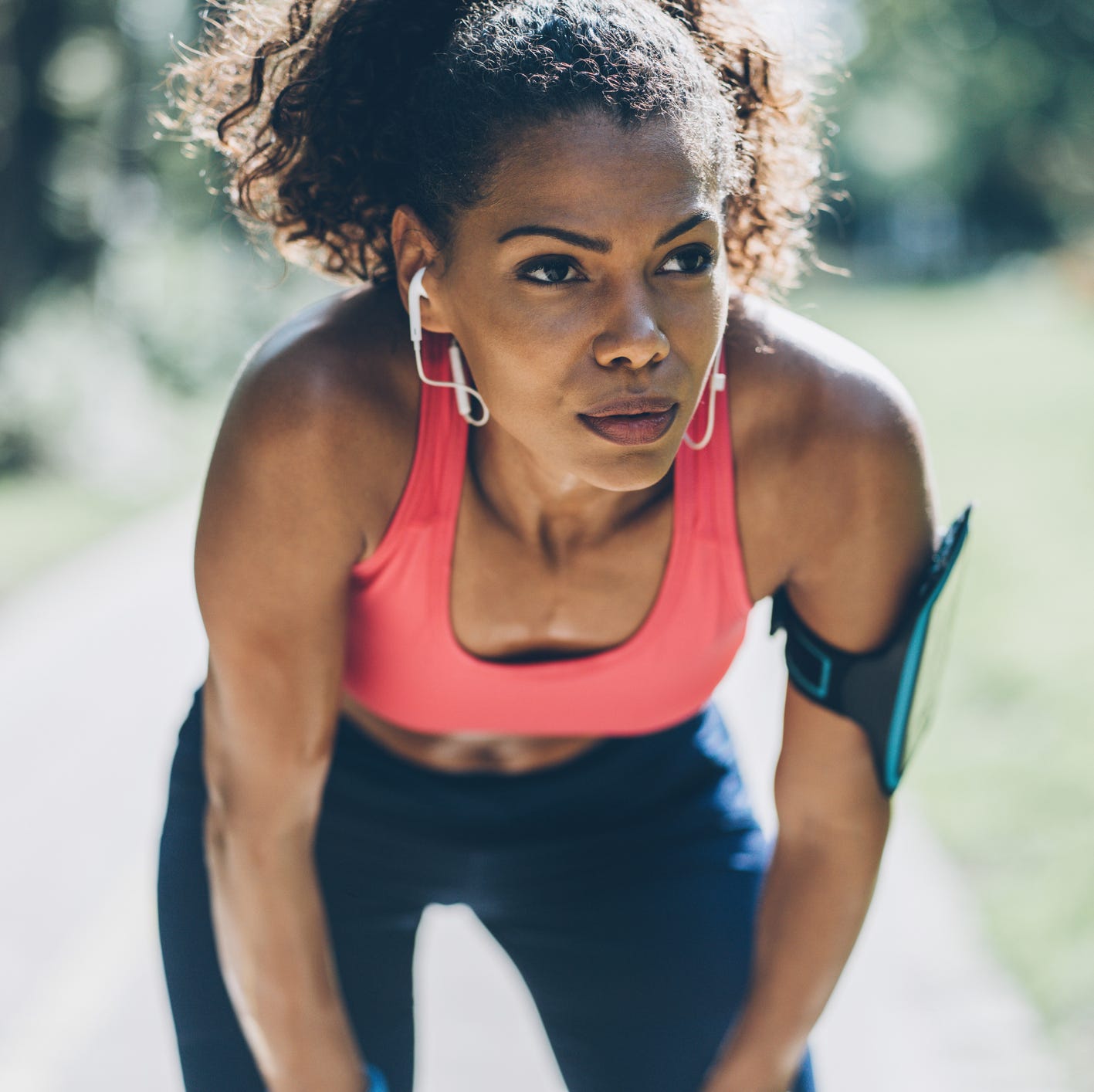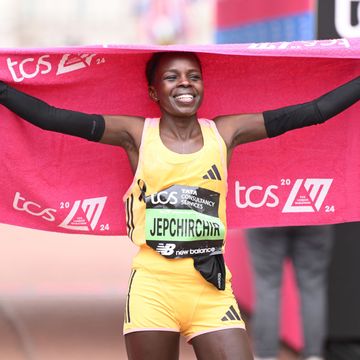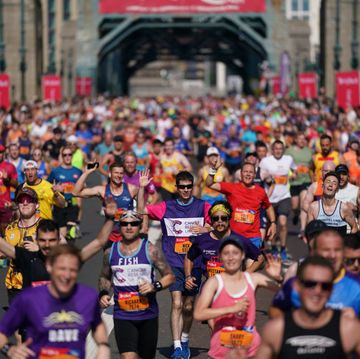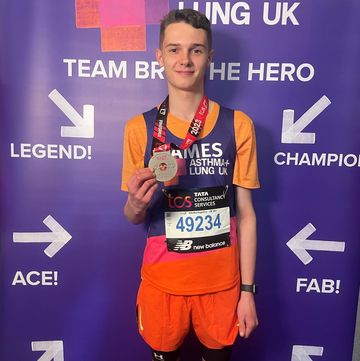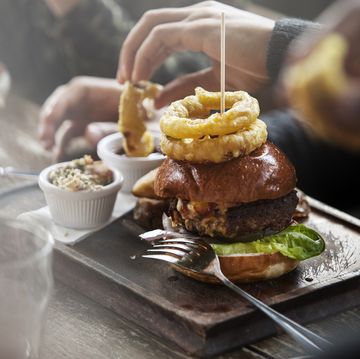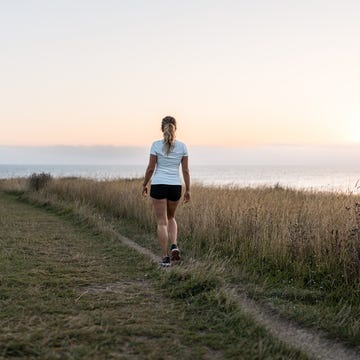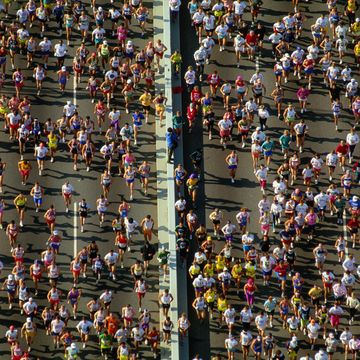First, some good news: the Met Office weather forecast suggests temperatures for the London Marathon will be a bit chilly, but conducive to quick marathon running. At 9am, temperatures in London are predicted to be 6ºC, with a light northerly wind and cloud cover. The temperature will rise through the day, likely peak of 13ºC around 3pm. Chances of rain are small at around 10%.
Although things might feel a little chilly on the start line, it's certainly a lot better than the temperatures experienced at the 2018 London Marathon – the hottest on record – when runners battled 25ºC heat.
Having said that, it’s still perfectly possible to run well even when temperatures do heat up. Think of all those awesome Olympic performances in the summer, like the 1996 Atlanta Olympics, where Portuguese distance star Maria Fernanda Moreira Ribeiro set an Olympic 10,000m record in hot, humid conditions of 27.7°C.
In research published in Comprehensive Physiology, Daniel Lieberman, the renowned Harvard evolutionary biologist and author of The Story of The Human Body suggests that our heat tolerance probably results from the fact that our ancestors evolved to hunt and forage on the African savannah at midday, when they were relatively safe from less heat-tolerant predators. Wherever we may live now, he suggests, we still largely retain these ancient heat-tolerance genes. ‘Heat is a paradox,’ says Lieberman. ‘On the one hand, we evolved to run in heat. But on the other, if you are not well adapted, heat can be mighty dangerous.’
So we asked the experts what to expect, and how to cope when the mercury rises...
Running in temperatures between 10-15°C
Most of us certainly don’t think of this as hot, but the longer the run, the more that even milder temperatures can affect you. Research back in 2007 by a team led by exercise physiologist Matthew Ely and published in Medicine & Science in Sports & Exercise, looked at decades of elite and sub-elite marathon performances at varying temperatures. They found that even at temperatures of 10-15°C, there was a drop in performance of one to two minutes for a 2:10 marathoner, depending on whether the race was at the top or bottom end of the temperature range. For three-hour runners, the slowdown was four to eight minutes. (Slower runners weren’t studied.) However, this is contradicted by other research that has found that 7-15°C is in fact the ideal temperature for most runners. And in good news for women, Ely’s research showed that they fare better in warmer temperatures than male runners.
Physiologically, running in warmer temperatures produces a cascade of reactions that begin with the fact that our muscles aren’t actually all that efficient. In fact, says exercise physiologist Dr Yannick Molgat-Seon at the University of Ottawa, Canada, 80% of the energy generated by our muscles ends up as heat. In cold weather, that inefficiency is what keeps us warm. But during exercise, the body has to get rid of it. One way is by sweating. ‘Less obvious is promoting blood flow to the skin,’ says Molgat-Seon. That’s important because it’s what carries excess heat from your muscles to the skin, where it can be lost to the environment.
But the body only has so much blood. ‘You have a competition between blood going to the skin and blood to the active muscles,’ says Molgat-Seon. ‘In that battle, the muscles always lose.’ So even when you’re only lightly sweating, your muscles are getting less oxygen and therefore are less efficient.
Running in temperatures up to 20°C
These are temperatures at which many of us start to view conditions as less than perfect, especially at the top end. The Run SMART Project calculator by Jack Daniels, author of Daniels’ Running Formula, calculates that at 20.5°C, a 45-min 10K runner will be 41 seconds slower. For marathoners, Ely’s study found a one- to four-minute slowdown for top-level elites and three-hour runners.
However, your body adapts quickly when you start training in the heat. Within a week your blood plasma volume starts expanding. That may actually increase your weight by a pound or two, but more importantly it gives you more fluid to sweat away, without leading to dehydration. It also makes it easier for your body to supply blood to the skin without overly reducing flow to the muscles.
You start to sweat earlier in your run, as your body learns to anticipate the build-up in core temperature. You also sweat more, and your sweat becomes less salty, as the body conserves sodium. And your heart rate slows down slightly, allowing the heart to fill more between beats, so it has more blood to pump out.
Even your perception of hot weather running effort changes. One or two hot days may feel unusually difficult, but within a week to 10 days of a more sustained spell, runners may adapt surprisingly well.
Running in temperatures between 20-26°C
At these temperatures, Ely’s elite marathoners slowed down by three minutes, with the sub-elites losing up to 20 minutes. However, not all runners are affected equally: Ely’s data crunching revealed conclusively that women fare better in heat than men. The most likely explanation for this is that women, being smaller than men, have a higher surface-to-mass ratio, which allows them to get rid of heat more efficiently.
It’s not just women who benefit from being more petite, however. In the men’s marathon at the Atlanta Olympics (which was run at a starting temperature of 23°C, with 90% relative humidity), the winner, South African Josia Thugwane, weighed just over 7st at 5ft 2in. The silver medallist, South Korean Lee Bong-ju, weighed a shade under 9st.
And the correlation between heat and body size doesn’t only affect marathoners. In laboratory experiments conducted shortly before the 2004 Athens Olympics, exercise physiologist Tim Noakes, author of Lore of Running, found that when the room temperature was ramped up to 35°C, smaller men ran an average of 45 seconds per mile faster than larger men in an 8km treadmill time trial. In cool temperatures, the two groups performed about equally. The principle also applies at less extreme temperatures.
Running in temperatures between 26-31°C
There comes a point when additional sweating doesn’t do you any good. ‘When you’re dripping sweat, there’s lost water as opposed to lost heat,’ says Molgat-Seon. You also begin to run into the limits of not only your body but of physics: there are conditions in which no matter how efficiently you sweat, it won’t evaporate fast enough to keep pace with the rate at which you are generating heat. Your only alternative is to slow down.
‘When air temperature exceeds 26°C and the humidity exceeds 70%, performance drops markedly,’ says Armstrong. Training your body to do its best under these conditions requires dedication. If you have a race coming up in which you anticipate hot, humid conditions, training for that environment will make a difference – in a heat chamber or with multiple extra clothing layers if necessary.
But just as you taper off your training volume before important races, you should also back off any heat training in the day or two before the race, trusting that the adaptations have already taken place and what you now need to do is make sure your body is not overstressed on the start line.
If, on the other hand, you weren’t expecting your race day to be in the middle of a heatwave – remember to take on lots of electrolytes, not just during your race, but in the days leading up to it, to stay on top of your hydration.
Running in temperatures 32°C+
Not a problem we often have in the UK, of course, but you may face these conditions during a heatwave or while training on holiday. And it’s no surprise that the hotter it is, the harder it is. When American elite Kara Goucher was preparing for the 10,000m World Championships in 2007, she knew that Japanese summers are notorious for hot, humid conditions. Race day in Osaka was no exception. ‘[It] was humid and stifling,’ she says, remembering a temperature of 31°C, with high humidity.
But she’d trained carefully for the event, doing summer track workouts in tights and long sleeves, as well as easier runs in ‘sauna suits – jacket and pants that were basically like rubber’. She went to Japan two weeks before the race. ‘By race day, I knew I could handle it,’ she says. She took the bronze medal.
The key to running in extreme conditions, says Greg Pressler, a veteran of the brutal Badwater 135 – an ultra run in the searing temperatures of Death Valley, California – is thinking about everything that might affect your performance, whether it’s monitoring pace or your choice of clothing. Stints in a sauna can also help with preparation.
You also need to keep on top of your hydration, even for shorter races, making sure you use electrolyte tablets and products to replace the sodium and other minerals which you will lose when sweating. Taking such steps will pay off with larger blood volume and greater resistance to dehydration.
You can also train yourself to drink more liquids. You won’t be able to exceed one litre per hour, but most people aren’t used to consuming even that much, says Pressler, which means that when you’re training for hot conditions, it’s quite easy to become dehydrated. However, when increasing your fluid intake it's important to not overdo it – over-hydration is also dangerous – and to take on plenty of electrolytes. Read our guide to using electrolytes and staying hydrated while running.
The keys to not only surviving a hot race, but also doing well, boil down to ‘hydration, practising the conditions, and getting there early,’ says Goucher.
Like this article? Sign up to our newsletter to get more articles like this delivered straight to your inbox.
